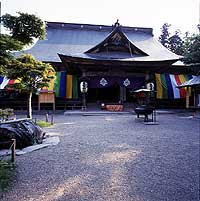
| Pseudonym reading | University |
|---|---|
| Specified type | Country designation |
| Type | Special historic sites |
| Designated date | May 22, 1979 |
| Specified details | September 30, 2004 addition |
| quantity | |
| location | Hiraizumicho Hiraizumi Chusonji Temple |
| owner | Chusonji Temple Outside |
| Holding group | |
| Management organization | |
| home page | Hiraizumi's cultural heritage |
Overview
Chuson-ji Temple is located at the northern end of Hiraizumi-cho, Izueki, and the precinct covers the entire hilly area called Kanzan.
According to Teraden, it was held by Jiseiko 3 years (850) and was originally called Kodaisujiin, but it was given the name of Chuson-ji Temple by Emperor Kiyowa in the first year of 811 It is said.
According to Chusonji documents "Kenbu first year August general complaints" and the extant Chusonji temple bells inscription by Yasunaga in 1972, the first time Kiyoshin Fujiwara embarked on the construction of Chusonji Temple was in 1105.
The purpose of Doto erection is described in the “Dakesei memorial service statement” in the first year of Oji (1126).
According to this application, Chusonji Temple has three sides, three sides, 22 rooms on the left and right, 22 triple halls, three triple towers, second floor rubble, one floor, a second floor bell tower, and Daimon three letters, There are three fences, one antibridge, one oblique bridge and ten.
In addition, there is "Azumagama", the above-mentioned popular complaint, as a document that describes Chuson-ji in the past, but the contents of the description do not match.
Excavation investigation was carried out in 1955-1943 (1953-1968), and many remains such as Daikinedo trace, Tagou trace trace, Oike trace, Mieike trace, Kokeisaku trace were detected, but it is not always consistent with the literature Absent.
Chusonji Temple faded after losing Fujiwara, and in particular, most of the temple towers were destroyed by fire in Jenbu 4 (1337), and the buildings at that time only left the Golden Hall and the Kozo. It has many national treasures and important cultural assets such as sitting statues.
